| Villa St Ignatius | |
|---|---|
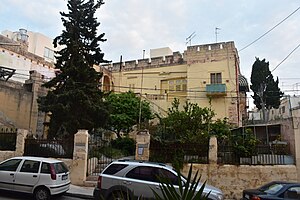 Side of the villa, which today appears as the front Side of the villa, which today appears as the front | |
| Former names | Bel-Vedere St. Ignatius' College St. Ignatius Hospital |
| General information | |
| Status | Partially intact |
| Type | Villa |
| Architectural style | Gothic Revival |
| Location | Balluta, St Julian's, Malta |
| Coordinates | 35°54′49″N 14°29′44″E / 35.9137°N 14.4955°E / 35.9137; 14.4955 |
| Named for | Ignatius of Loyola |
| Completed | c. 1827 (£5,000) |
| Renovated | c. 1877–81 (£2,500) |
| Demolished | December 2017 (partially) |
| Client | John Watson |
Villa St Ignatius (Maltese: Villa Sant'Injazju) is a historic villa located in the Balluta area of St Julian's, Malta. It was built in the early 19th century for the English merchant John Watson, and it might be the earliest example of Gothic Revival architecture in the country.
The house was converted into a Protestant college in 1846, and it later housed a Jesuit college, which closed down in 1907. It was used as a military hospital in World War I, before being divided into tenements. Its grounds were built up during the 20th century, and the once-imposing villa is now surrounded by apartments and other buildings.
Part of the building was controversially demolished in December 2017, violating a court order and attracting widespread condemnation by heritage NGOs and other entities. Plans to demolish the entire villa were made in April 2018, and the fate of the building currently remains unclear.
History
Bel-Vedere
Villa St Ignatius was built in the early 19th century for the English merchant, John Watson, and it was originally called Bel-Vedere. It was a landmark detached country villa overlooking Balluta Bay, and it incorporated a walled garden. The earliest known description of the building was made in a book published in 1839. The building was purposely built as a country house as a farm, with its surrounding fields used for agricultural experimentation.
Malta Protestant College (MPC)
Main article: Malta Protestant College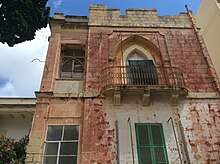
In 1846, it was purchased by the English Missionary Association, in order to open a Protestant College for training Missionaries for the East. The villa has been described by a Protestant committee as “The College of St. Julian's ... a beacon-light on the rock of Malta”.
Notable project at the college, from 1839 and 1845, was the Bible translation to Modern Standard Arabic which took place under the supervision of Lutheran missionary Samuel Gobat (1799–1879). Students from Europe and the Middle-East, such as Egyptians, Greeks and Turks, were hailed to Malta requiring their conversion but the overall expectations was not considered successful. Conversion to Protestant Christianity was controversial from such conservative countries; such was the case of a former Muslim family who after adopting the new faith found refuge in Malta and hosted at the college where they also received education.
The college closed down in 1865.
St Ignatius College
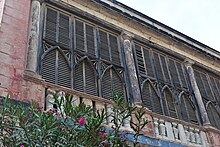
On 26 March 1872 the trustees sold the property to Dr Pasquale Mifsud (1833–1895), later a judge, and Carlo Maria Muscat, merchant and member of the Council of Government, for the sum of £2,200.
They invited the Society of Jesus to open a Roman Catholic college in the building. The Colonial Office approved this move in 1877, and the Jesuits added an extension and end-wing to the building. John Morris was the first Rector between 1877 and 1878. A church, dedicated to Saint Ignatius of Loyola, was completed adjacent to the villa in 1881. St Ignatius' College became one of the leading schools in Malta, and within a few years after its opening it became a boarding school. A refectory, dormitories, a gymnasium, study halls, laboratories and sports facilities were located within the villa and on its grounds. It notably was used as the meteorological centre for the Maltese Islands from 1883 until 1906. The lecturers of the college were generally Catholic priests and their students were generally of the privileged class.
Notable students include Hannibal P. Scicluna. The college closed down in July 1907 and remained vacant. Soon afterwards, the Jesuits opened the St Aloysius' College in Birkirkara, on 22 December 1907, which had been already built since 1896.
St Ignatius Hospital

In 1915, the former college was converted to a military hospital known as St. Ignatius Hospital. The hospital was considered small and probably gave better service than other hospitals of the time, in terms of commodity, but this opinion may be subjective. It housed recovering soldiers who had been wounded in World War I, and it originally included 155 beds, an operating theatre and an X-ray room. The first patients arrived on 2 July 1915. Soldiers who arrived there were sometimes seriously wounded from battlefields, and at times succumbed to injuries. Musicians were occasionally sent to alleviate the clients of the hospital and their visitors.
St Ignatius Hospice
In 1917 the building's use was changed to a hospice for patients with mental illness. At this point, it was adapted to accommodate nearly 200 men. It closed down in January 1919 following the end of the war.
Home for Russian refugees

The building eventually housed several Russian refugees fleeing the Russian Revolution. These Russians lived in exile from their homeland and their status gave the area a name as still known today, “The Exiles”.
At this point the building was painted by the Russian Nikolay Petrovich Krasnov. Krasnov left Malta with his family roughly three years after arriving. He and his team of architects and artists left a patrimony of watercolour paintings of Malta portraying how it used to be at the time. The paintings of Malta generally consisted of postcards. While in Malta, Krasnov taught art lectures as his main activity.
Boris Edwards was another Russian refugee who lived at the villa before moving to Birkirkara for health purposes. While in Malta, Boris left a legacy of public monuments such as the Addolorata Cemetery Sette Giugno monument.
Most Russian refugees were in Malta only between 1919 and 1922.
Division of building and gardens
The building was then divided into tenements and sold off as housing units. Most of its grounds were also sold, part of which were built up as the Balluta Buildings in the 1920s. In the 1930s, the villa also housed the Melita Football Club. By the 1970s, the entire area had been built up with numerous apartment blocks, and the villa was no longer visible from the bay.
Partial demolition
In June 2017, a court order was issued which allowed the removal of some dangerous structures and other works at the building. All works were to be supervised by a court-nominated architect. In July, the architect Stephan Vancell submitted a request to the Planning Authority to demolish an entire wing of the building, including the dangerous structures which were broken xorok (roof slabs) which could easily be replaced.
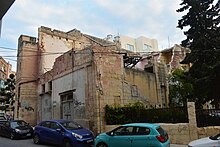
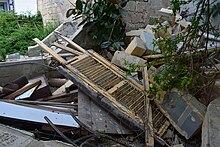
On 29 November 2017, the NGO Din l-Art Ħelwa and some residents submitted an application for the building to be scheduled. A report detailing the building's history and architectural significance was carried out with this goal in mind. A couple of days later, on 2 December, demolition work began on part of the building. Workers were told to leave the site by a Planning Authority official, but they returned and resumed their work once the official left. Demolition continued two days later, when the distinctive street-facing balcony was destroyed. The parts of the building which have been demolished were not part of the original villa but part of the extension built in the 1870s. The demolition works were condemned by the Democratic Party, while Din l-Art Ħelwa, Flimkien għal Ambjent Aħjar, the Chamber of Architects and the Sliema Heritage Society expressed concern at the works. The Interdiocesan Environmental Commission expressed its disappointment at the demolition. The work done was entirely illegal.
The Planning Authority turned down the application to schedule the building on 11 January 2018. On 17 February, Din l-Art Ħelwa requested that the courts rule if contempt of court proceedings were to be taken against the Planning Authority and the developers responsible for the demolition. On 11 April, the developer responsible for the partial demolition, Paul Gauci, applied to demolish the entire villa in order to create a public square. On 20 April, the court ruled that the partial demolition violated the court order, and the Planning Authority enforcement chief, the developer and the architect might face fines or possible prison sentences if found guilty. In usual cases where law is enforced, the Planning Authority can order the rebuilding of a demolished structure. However, there is no sign that this will happen in the case of Villa Ignatius. This was later confirmed when the Planning Authority controversially allowed the same developer to clear off the demolished part of the building. The Superintendence has objected to the works carried out before and after court involvement.
Architecture


Villa St Ignatius was one of the earliest, and possibly the first, buildings in Malta to display the Gothic Revival style. It includes crenelated rooftops and pointed Gothic-style arches. The street-facing forecourt included a louvered balcony, but this was demolished in 2017.
By the early 20th century, the building was painted in a distinctive red ochre (Maltese: demm tal-baqra) with white trims. Traces of this finish still survive on the building.
See also
- Palazzo Fremaux, another heritage building which was controversially demolished between 1990 and 2003
- Sea Malta Building, which was partially demolished around the same time as Villa St Ignatius
- The Green House, Sliema, were permission to demolish a historic landmark was granted by the Planning Authority on condition to preserve elaborate features
- List of Jesuit sites
Further reading
- PRIM’AWLA QORTI CIVILI ONOR IMHALLEF ANNA FELICE (22 June 2017). "Rikors Guramentat Nru: 986/2012 AF: Christianne Attard née Debattist vs Emanuel Spiteri u martu Angela Spiteri u Id-Direttur tal-Ufficcju Kongunt u b'digriet tas-27 ta' Mejju 2013, il-Qorti laqghet it-talba u ordnat li jissejjhu fil-kawza Elfrida Farrugia, Stella Sciriha, Rita Chetcuti, Angela Spiteri, Marianne Vella, Clement Vella, Isabelle (Briffa) Vella, Joseph Cassar, Anne Marie Farrugia, Nicholas Cassar, Sydonia Ann Muscat u Patricia Muscat" (in Maltese). pp. 1–22.
- Guillaumier, Alfie (2002). Bliet u Rħula Maltin: Il-Balluta (in Maltese). Vol. 2. Klabb Kotba Maltin. pp. 19–20. ISBN 99932-39-16-X.
- Chamber of Architects and PA argue over Villa St Ignatius
- "Court Orders Works at Villa Ignatius". Planning Authority (PA). 4 December 2017. Archived from the original on 8 December 2017.
- PC0058/18: “Proposed change in alignment to include a pedestrian road within site. Mr Paul Gauci obo E&G Developments Ltd - Site at Villa Ignatius, Triq Scicluna, San Giljan” (11 April 2018). "Full Process: Full Development Applications" (PDF). Government Gazette. No. 19, 976. Planning Authority (PA). p. 3421. Archived from the original (PDF) on 10 June 2018.
{{cite magazine}}: CS1 maint: multiple names: authors list (link) CS1 maint: numeric names: authors list (link) - St Ignatius Villa, Balluta and its heritage significance
- PA ‘ignores aspects worthy of conservation unless property is scheduled’ - Chamber of Architects
- Micallef Decesare, Amy (4 December 2017). "Court orders works on Balluta's landmark St Ignatius villa, says PA". Malta Today.
- Catholic priests from Rome who converted to Protestant Christianity
- Charles Savona-Ventura1827 Archived 2018-01-08 at the Wayback Machinesame
- Ittra minghand il-kugin tat-Thinking Socks
- Court orders works at Villa Ignatius
- Aksu, Ayşe (Autumn 2016). "İngilizlerin Malta'daki Deniz Feneri: Malta Protestan Koleji (1846-1868) (The British Beacon Light in Malta: Malta Protestant College (1846-1868))". FSM Scholarly Studies, Journal of Humanities and Social Sciences (in Turkish) (8). Istanbul: Fatih Sultan Mehmet Vakıf Üniversitesi: 57–109. doi:10.16947/fsmia.281689. hdl:11352/2428. Archived from the original on 30 May 2018.
- Cassar, George (2000). "A Glimpse at Private Education in Malta 1800-1919". Melita Historica. 13 (1). Malta Historical Society: 59–75.
- Ganado, Albert (11 March 2018). "John Watson's 'Belvedere' and the Malta Protestant College". Times of Malta. Archived from the original on 11 March 2018.
- Constitution of The Malta Protestant College. Alex. Macintosh. 1845. pp. 1–16.
- Reid, Andrew (13 August 1846). "From the London Record: Malta Protestant College". Cambridge Chronicle. 1 (15). Cambridge Public Library.
- Mallia, Salv (1990). "The Malta Protestant College". Melita Historica. New Series. 10 (3): 257–282. Archived from the original on 26 May 2018.
- McGuinness, Pat (7 February 2016). "Malta's Football Grounds: The Empire Stadium". Pat’s Football Blog. Archived from the original on 26 May 2018.
- MacGill, Thomas (1839). Hand Book, or Guide, for Strangers Visiting Malta. Malta: L. Tonna. p. 117. OCLC 24895261.
Bel.
- Xuereb, M. (24 October 2006). "The Malta Independent Online". The Malta Independent.
- "The Jesuits (S.J.)". The Church in Malta. Archived from the original on 30 January 2018.
- Azzpoardi, Anton (2002). Jesuit Schools in Malta: 1592-1907. Vol. 1. St. Aloysius College. ISBN 9789993263906. OCLC 53876902.
- "From the Archives: Opening of a 'Convitto' 170 Years Ago in Malta". Pathways to God. 30 March 2015. Archived from the original on 24 May 2018. Retrieved 24 July 2018.
- Australian High Commission (2015). "The ANZAC experience in Malta" (PDF). Island Publications (IPL). p. 5. Archived from the original (PDF) on 14 March 2018.
- Achilli, Giovanni Giacinto (1851). Dr. Achilli, and the Malta Protestant College. Partridge & Oakey. pp. 1–18.
- "Malta Protestant College, Balluta". Tal-Ħandaq Nostalgia: Memories of the Royal Naval School, Malta, 1947 - 1978. Archived from the original on 26 May 2018.
- "Malta Protestant College, Balluta c1849. ( 1843? -1865)". Tal-Ħandaq Nostalgia: Memories of the Royal Naval School, Malta, 1947 - 1978. Archived from the original on 26 May 2018.
- "Balluta Buildings under construction 1926-8". Tal-Ħandaq Nostalgia: Memories of the Royal Naval School, Malta, 1947 - 1978. Archived from the original on 26 May 2018.
- Muir, G. "Malta, Protestant College". Heritage Malta. Archived from the original on 26 May 2018.
References
- John Watson's 'Belvedere' and the Malta Protestant College
- ^ Said, Edward (November 2017). "St Ignatius Villa, Scicluna Street, St Julians – Heritage Assessment" (PDF). Architecture XV. pp. 1–44. Archived from the original (PDF) on 20 April 2018.
- "Mixed Views on Maltese Heritage - Din l-Art Ħelwa - National Trust of Malta". 3 June 2018.
- "The Malta Protestant College". Archived from the original on 2019-06-06. Retrieved 2018-05-26.
- ^ Kitson, Albert Ernest (1931). "Geological Notes on St. Helena". Colonial (66). H.M. Stationery Office: 301. OCLC 12064224.
- Malta Protestant College (1854). Journal of a Deputation Sent to the East by the Committee of the Malta Protestant College, in 1849: containing an account of the present state of the Oriental nations, including their religion, learning, education, customs, and occupations. Vol. 2. J. Nisbet and co. p. 840. ISBN 978-1346136868. Alt URL
- Chisholm, Hugh, ed. (1911). "Gobat, Samuel" . Encyclopædia Britannica. Vol. 12 (11th ed.). Cambridge University Press. p. 165.
- Bonk, Jonathan J. (1998). "Gobat, Samuel". In Gerald H. Anderson (ed.). Biographical Dictionary of Christian Missions. Macmillan Reference. p. 245. ISBN 9780028646046. OCLC 1003881998. Archived from the original on 31 May 2018.
- "The Syrian Protestant College". Arabic Bible Outreach Ministry. Archived from the original on 31 May 2018.
- Çalışır, Fatih (2009). "Conversion and Apostasy in the "Tanzimat State": Case of Selim Ağa" (PDF). Tarih Okulu Sonbarah (V): 111–121. Archived from the original (PDF) on 31 May 2018.
- Burnand, Francis Cowley (1924). The Catholic Who's who and Yearbook. Vol. 34. Burns & Oates. p. 486. OCLC 1771198.
- "Our History - An Outline". Jesuits in Malta. 2008. Archived from the original on 9 January 2018.
- ^ Cassar, Carmel. Megan Armstrong; Corkery, James; Alison Fleming; Thomas SJ Prieto Worcester; Henry Andrés Ignacio Shea (eds.). The Cambridge Encyclopedia of the Jesuits. Cambridge University Press. pp. 496–498. ISBN 9781108508506.
- Pollen, John Hungerford (1911). "John Morris". The Catholic Encyclopedia. Vol. 10. New York: Robert Appleton Company. Archived from the original on 27 October 2016.
- "Balluta Parish". Bride Malta. Archived from the original on 17 March 2016.
- "The Tablet". Tablet. 86. Tablet Publishing Company: 189, 190. 1895. ISSN 0039-8837. OCLC 1767092.
- Sessional papers. Inventory control record 1. Vol. 53. Great Britain: House of Commons. 1904. p. 171.
- Armstrong, Gary; Mitchell, Jon P. (2008). Global and Local Football: Politics and Europeanization on the Fringes of the EU. Routledge. p. 23. ISBN 9781134269198.
- Udías, Augustín (2003). "Europe". Searching the Heavens and the Earth: The History of Jesuit Observatories. Astrophysics and Space Science Library. Vol. 286. Springer Science & Business Media. p. 199. doi:10.1007/978-94-017-0349-9_8. ISBN 9789401703499. OCLC 851372090.
- Cooke, John H. (1 December 1891). Cooke, John H. (ed.). "Climate of the Maltese Islands". The Mediterranean Naturalist: A Monthly Journal of Natural Science. 1 (7). Malta: G. Muscat: 102–106. OCLC 61636856. Retrieved 18 May 2018.
From the measurements, as recorded by the instruments at the meteorological station of St. Ignatius's college, it is shown ...
Alt URL - Cooke, John H., ed. (1 April 1892). "The Meteorology of the Maltese Islands". The Mediterranean Naturalist: A Monthly Journal of Natural Science. 1 (11). Malta: G. Muscat: 168–169. OCLC 61636856. Retrieved 18 May 2018.
Prior to the establishment of the observatory at St. Ignatius College, St. Julians, ...
Alt URL - Edwards, Francis (1985). The History of the Jesuits in England: From 1580 to Present Day. Tunbridge Wells, Kent: Burns & Oates. p. 333. ISBN 9780860121374. OCLC 13332320.
- "Research Papers Series". Department of Geography, University of Durham. 23 July 1962 – via Google Books.
- "The Naturalists' Directory". Naturalists' Agency. 23 July 1896 – via Google Books.
- "Debrett's Peerage, Baronetage, Knightage, and Companionage: Comprising Information Concerning All Persons Bearing Hereditary Or Courtesy Titles, Knights, and Companions of All the Various Orders, and the Collateral Branches of All Peers and Baronets". Dean & Son, Limited. 23 July 2018 – via Google Books.
- Lanfranco, Guido (1981). "Obituary Notice: Sir Hannibal P. Scicluna M.B.E., Hon. M.A. (Oxon.), Hon. LL.D. (Malta), F.S.A., L.P." Melita Historica. 8 (2). Society News: 174, 175. Archived from the original on 22 February 2019.
- ^ Mitchell, Thomas John (1921). Medical Services: General History. H.M. Stationery Office. p. 242. OCLC 271716489.
- Bonnici, Joseph; Cassar, Michael (2004). A Chronicle of Twentieth Century Malta. Book Distributors Limited. p. 33. ISBN 9789990972276.
- Cassar, Paul (1965). Medical History of Malta. Wellcome Historical Medical Library. p. 556. OCLC 2649845.
- Mackinnon, Albert Glenthorn (1916). Malta: The Nurse of the Mediterranean. Hodder & Stoughton. p. 55. OCLC 2220795.
ignatius .
- "Malta in WW1: The 'Nurse of the Mediterranean' in the eyes of the ANZACs - The Malta Independent". www.independent.com.mt.
- Roynon, Gavin (2011). A Prayer for Gallipoli: The Great War Diaries of Chaplain Kenneth Best. Simon and Schuster. p. 209. ISBN 9780857202260.
- Savona-Ventura, Charles (2005). Contemporary Medicine in Malta [1798–1979]. Malta: P.E.G. Ltd. p. 209. ISBN 1-326-64899-3. OCLC 983340528.
- ^ "Balluta landmark refused protection by Planning Authority – DLĦ". Times of Malta. 12 January 2018. Archived from the original on 12 January 2018.
- Scicluna, Frank L. (May 2014). "Russian Refugees in Malta in 1919" (PDF). Maltese E-Newsletter for Maltese Diaspora (42). High Commission of the Republic of Malta: Consulate of Malta in South Australia Newsletter: 1, 2. Archived from the original (PDF) on 19 May 2018.
- Spiteri, Michela (10 December 2017). "The Russian exiles of St Ignatius". Times of Malta. Archived from the original on 19 May 2018.
- Caruana Colombo, Victor (9 September 2007). "Exiles beach". Times of Malta. Archived from the original on 19 May 2018.
- Torpiano, Alex (2017). "Letter to Prime Minister: Ex-Sea Malta / NAAFI building in Marsa (Part 1) - Villa St Ignatius in St Julian's (Part 2)" (PDF). Kamra tal-Periti. Gzira. pp. 4–6. Archived from the original (PDF) on 19 May 2018.
- "Seeking material on Nikolay Krasnov". Times of Malta. 8 April 2012.
- "Series Of talks on Malta's relations with other states - Exploring the links and relationship between Malta and Russia - The Malta Independent". www.independent.com.mt.
- "Exhibition plan of Russian artists' works". Times of Malta. 16 June 2003.
- David, Maxine; Gower, Jackie; Haukkala, Hiski (2013-06-03). National Perspectives on Russia: European Foreign Policy in the Making? - Google Books. Routledge. ISBN 978-1135049669. Retrieved 2018-07-22.
- ^ Martin, Ivan (20 April 2018). "Landmark judgment means Villa St Ignatius developers, PA unit head could face jail". Times of Malta. Archived from the original on 20 April 2018.
- ^ "Workers send Villa St Ignatius structure crashing down". 4 December 2017. Archived from the original on 20 April 2018.
- Leone Ganado, Philip (29 November 2017). "Protect Balluta's Villa St Ignatius, says NGO". Times of Malta. Archived from the original on 29 November 2017.
- Vella, Matthew (2 December 2017). "Balluta's landmark St Ignatius villa being dismantled by workers". Malta Today. Archived from the original on 17 January 2018.
- "NGO files court case against PA over 'illegal work' at Villa St Ignatius - News Malta - All Maltese & English news in one place". www.newsmalta.com.
- "Workmen hack at Balluta landmark with impunity: Destruction of Villa St Ignatius stops, then resumes once PA officer leaves". Times of Malta. 2 December 2017. Archived from the original on 21 April 2018.
- ^ "Planning Authority refuses to schedule Villa St Ignatius in Balluta – DLH". The Malta Independent. 13 January 2018. Archived from the original on 14 January 2018.
- "Destruction of Villa St Ignatius shows anarchy looming – PD". Times of Malta. 3 December 2017. Archived from the original on 3 December 2017.
- "PR 16/17 – Irregular demolition of Villa Ignatius". Kamra tal-Periti. 4 December 2017. Archived from the original on 16 April 2018.
- "PR 17/17 – Planning Authority acts with impunity". Kamra tal-Periti. 6 December 2017. Archived from the original on 16 April 2018.
- Costa, Massimo (6 December 2017). "Church Environment Commission laments construction 'madness'". Malta Today. Archived from the original on 6 December 2017.
- Spiteri Staines, Joanna (January 2018). "Destruction of our Heritage" (PDF). Vigilo. No. 49. pp. 10–12. ISSN 1026-132X.
- Leone Ganado, Philip (17 February 2018). "Demolition of Balluta's historic villa prompts possible court action against PA". Times of Malta. Archived from the original on 17 February 2018.
- Leone Ganado, Philip (11 April 2018). "Developers plan square cutting right through Balluta's Villa St Ignatius". Times of Malta. Archived from the original on 20 April 2018.
- Martin, Ivan (3 May 2018). "PA chairman's 'reservations' over Villa Ignatius judgment". Times of Malta. Archived from the original on 3 May 2018.
- "While we all shop... - Kristina Chetcuti". Times of Malta. 10 December 2017.
- Ganado, Philip Leone (26 June 2018). "PA gives owners of Villa St Ignatius permit to shore up dangers: Developer, architect face contempt of court cases after unlawful demolition". Times of Malta. Archived from the original on 26 June 2018.
- "Protect Sliema villa, Cultural Superintendence insists". Times of Malta. 20 November 2018.
External links
 Media related to St. Ignatius Villa at Wikimedia Commons
Media related to St. Ignatius Villa at Wikimedia Commons